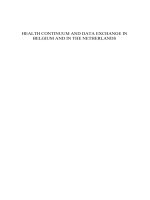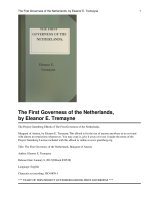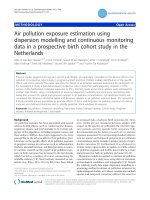The Netherlands, 1750-1813
Bạn đang xem bản rút gọn của tài liệu. Xem và tải ngay bản đầy đủ của tài liệu tại đây (110.98 KB, 21 trang )
2 The Netherlands, –
Nicolaas van Sas
On October Willem Anthonie Ockerse opened the winter series
of lectures in the Amsterdam society Doctrina et Amicitia with a talken-
titled ‘What’s
the news?’ in which he offered a light-hearted theory of
human curiosity. According to Ockerse, curiosity and above all the ask-
ing of the question ‘Wha
t’s the news?’ was a prime characteristic of the
condition humaine. Man – and certainly also woman – could only be ful-
filled in contact with other human
beings. Sociability and the continuous
exchange of views were part of human nature, and naturally gave rise to
the urge to hear and impart news. Self-interest was obviously an impor-
tant and daily inspiration for human curiosity. One person might have an
interest in inheritances, another in lotteries, a third in stocks, a fourth in
shipping news, a fifth in peace or war, a sixth in political events. ‘What’s
the news?’ was the first question one asked on entering polite society or
coffee house, towing-barge or coach, council chamber or theatre, even –
Ockerse added mischievously – sometimes church. In an ever-changing
world there was always a great appetite for news. But certainly the sad and
terrible events of recent years had added greatly to the demand for news.
‘Good heavens! How many things formerly unthought-of have happened
in the past years with an ever quickening sequence, the story of which has
made humankind cry, sigh and shiver!’ Ockerse profoundly hoped that
one day the reply to that perennial question ‘What’s the news?’ would be:
‘Good news! – order, quiet, peace, freedom, prosperity will return to the
peoples of the world, and to the Netherlands.’
Ockerse was not some obscure speaker. He was a well-known figure
in contemporary Dutch society, a theologian by training and long-time
practising minister, but first and foremost he was an intellectual, a typical
product of Dutch enlightened sociability. As such he was also a journalist –
co-editor of De Democraten, the best political journal of the Batavian
Revolution – a member of parliament in and and one of
the framers of the first Dutch constitution.
But perhaps his most en-
during claim to fame is his important study of Dutch national charac-
ter, published in , which propounds a theory of Dutch society and
The Netherlands –
national identity, aimed at furthering the cause of a Dutch state that
would be – like its French sister republic – ‘une et indivisible’.
In this study,
Ockerse stated that the Dutch people were traditionally very interested in
politics and possessed what he called ‘a general and popular knowledge of
political affairs and interests’. Their curiosity was continuously kept alive
by news from coffee houses, newspapers and the stockexchange.
In this
sense politics in the Dutch Republic wa
s
– as in England – ‘a rather com-
mon and favourite pastime’. Indeed, in his view everybody from the lofti-
est regent to the lowest porter used to ‘politicise’ in the Dutch Republic.
This was certainly true for his own time – the years immediately follow-
ing the Batavian Revolution of – but it was not a new phenomenon.
Traditionally, according to Ockerse, there had been an extensive supply
of news in the Dutch Republic
. However, since the beginning of the
American Revolutionary War this had expanded rapidly, reaching a new
high-point during the so-called Patriot Period of –, when sales of
political weeklies like De Post van den Neder-Rhijn and De Politieke Kruyer
(The Political Barrow-man) had reached unprecedented levels.
Ockerse was certainly right to stress the ready availability of news in
the Netherlands. From the early seventeenth century onwards, the young
Dutch Republic had established itself as the most important clearing-
house of international news. In the late sixteenth century, while still
fighting off their Spanish sovereign, the Dutch rapidly developed into
the foremost trading nation in the world. In the wake of this they also be-
came a great power politically. Interests of war and trade and its central
position in seventeenth-century geopolitics worked together to make the
Dutch Republic, and particularly the city of Amsterdam, the global nerve-
centre for the gathering and dissemination of news.
From on-
wards, we know of the existence of ‘coranto’: printed news-sheets which
mainly provided factual information from abroad, obtained from a net-
workof foreign correspondents. From about mid-century, in a process
of piecemeal innovation, these developed into regular newspapers, first of
all in Amsterdam, later also in several other towns in the core province
of Holland like Haarlem (), The Hague () and Leyden ().
All of these were commercial enterprises initiated by local printers.
Amsterdam had four officially recognised newspapers, appearing on dif-
ferent days of the week. However, by the end
of the seventeenth century,
they had merged into one, which in the eighteenth century was acquired
by the city government.
Very gradually during the eighteenth century,
other towns, at first mainly in the province of Holland, established their
own newspapers, normally by granting an exclusive privilege to a local
printer. By the middle of the eighteenth century, papers were being es-
tablished in the capitals of the outlying provinces, including Groningen
Nicolaas van Sas
(), Leeuwarden () and Middelburg (). The most impor-
tant of these news-sheets would appear three times a week, the smaller
ones once or twice. Whereas in the seventeenth century no more than
copies would have been printed, by the s this number had risen
to between , and , for the four largest papers, the Oprechte
Haerlemse Courant, the Amsterdamsche Courant, the Leydse Courant and
the ’s Gravenhaegse Courant.In the Amsterdamsche Courant reput-
edly sold , copies within the city and another , outside.
Though exact information is lacking, the readership was not evenly
distributed over the Republic. A rule of thumb may be that reading news-
papers was mainly an urban phenomenon and that the more densely
populated areas – above all the Holland heartland – would be over-
represented. The four ‘national’ newspapers mentioned above in the mid-
eighteenth century had a combined circulation of about ,.Ifthe
common estimate that each issue was read by some ten people is cor-
rect, their total readership must have been about ,, that is per
cent of the overall population of the country.
But looking at the towns
of the province of Holland in particular, it has been calculated that in
this period up to a third of their adult population – male and female –
must have been regular newspaper readers.
Indeed, when Ockerse said
that in the Dutch Republic everybody was interested in the news, he was
merely echoing a well-worn clich´e. Already in the s, the French am-
bassador d’Avaux said of the Dutch newspapers: ‘tout le peuple les lit ’.
In Amsterdam, the delivery people of the Amsterdamsche Courant were
expected to collect the papers very early in the morning, in summer at
. a.m., because the workmen used to read them in the tavern before
going to work.
Newspapers could not only be bought, they were also
rented out and they could be read in taverns and coffee houses, in the
stage-coach and, more comfortably, in the towing-barge.
The main newspapers were distributed nationwide and, judging from
the scant evidence available, apparently also abroad, in the southern
Netherlands, in Germany and in London.
Nonetheless, their geo-
graphical distribution patterns varied considerably. Whereas less than
per cent of the Amsterdamsche Courant was exported outside the city –
which, admittedly, housed per cent of the population of the Republic –
a majority of subscribers to the Oprechte Haerlemse Courant dwelt extra
muros.
The city of Amsterdam would expect to make between ,
and , guilders profit a year from its ownership of the Amsterdamsche
Courant,
but other towns charged a so-called ‘recognition fee’ for the
exclusive privilege to publish an urban newspaper. These papers would
also be expected to print official publications free of charge. Even when
exact figures are lacking, increases in the recognition-fees – especially in
The Netherlands –
the s – are a clear indication of the growing circulation of the urban
newspapers.
These stiff costs would be partly met from the income of
advertisements, typically placed crossways in the margins of the paper.
Advertisements could contain anything from inquiries about missing per-
sons or pets, medicine, lotteries, trees and shrubs, the sale of houses
and – last but not least – new books.
Though these newspapers were local ventures, local news was not their
mainstay. Rather, the editors had to be careful not to overstep the bound-
aries set by city regents, who were not at all willing to have their local
arcana out on the streets. The news – including commercial and shipping
information – was presented in an objective, concise manner, painstak-
ingly avoiding any colouring or editorial comment. The writers of the
Amsterdamsche Courant in were given very explicit instructions on
what not to publish. They were not supposed to print anything concern-
ing the military po
wer of the Republic and were only allowed to publish
information on domestic political affairs after having obtained permis-
sion beforehand. The style of the paper had to be simple, unostentatious,
unambiguous and impartial. It should avoid offending any person, either
high or low, political, military or religious, friend or enemy.
Despite
these limitations set by local authorities, the particularist political struc-
ture of the Dutch Republic ensured a considerable freedom of the press,
precisely because there was no central authority to enforce effective con-
straints. This was not so much freedom in principle as a practice of
freedom, which in hindsight, however – like the similar matter of religious
and political tolerance – came to be regarded as a matter of principle in
which the Dutch Republic had stood out in contemporary Europe.
News-sheets were important because they made the Dutch Republic
a very news-oriented society, but judging from their contents they were
relatively unspectacular. Apart from them, the Dutch press scene of the
ancien regime had two prime characteristics. One was a blossoming pam-
phlet culture which made up in newsworthiness, juiciness and political
outspokenness (though not in objectivity and reliability) for what the ra-
ther staid newspapers lacked. All political crises in the Dutch Republic,
but also all sorts of local conflicts, scandals and religious disputes, were
accompanied and fuelled by a surge of pamphlets. Far more than the reg-
ular newspaper press these ‘flying leaflets’ profited from the so-called
‘tempered freedom’ of the press
and the fragmentation of jurisdic-
tion which lasted till the Batavian Revolution of –. The other feature
of the Dutch journalistic scene was the existence of an important French-
language press, especially since the Dutch Republic had become a refuge
for French Huguenot exiles. This French-language press – of which
the Gazette d’Amsterdam was an early example, and the Gazette de Leyde
Nicolaas van Sas
eventually the most celebrated
– contributed far more than the in-
digenous Dutch journals to the fame of the Dutch Republic, making
it a byword for freedom and tolerance in the international Republic of
Letters.
Around , some important changes tookplace in Dutch society, as
historical research of the past twenty years has demonstrated time and
again.
Outside the recognised sphere of politics and the political struc-
ture, which was still that fossilised medieval jumble fought over by the
Dutch Revolt, a new civil society emerged, bringing with it a reorganisa-
tion and redefinition of the public sphere. This rearrangement of public
space made full use of the existing flexibility of Dutch society, through
the practical freedom already mentioned and the absence of a central
authority in internal affairs, which were organised on a local or, at most,
provincial basis. This cultural shift marked
the breakthrough of a dis-
tinctly Dutch Enlightenment. This ‘Dutchification’ of the Enlightenment
had
far-reaching consequences for Dutch culture, society and also
poli-
tics. Establishing what was national, especially in terms of culture, lan-
guage and literature, came to be one of its defining characteristics.
The
rearrangement of public space in the Dutch Enlightenment created an
‘imagined community’ in the sense of Benedict Anderson:
a community
of people who did not – and indeed could not – know one another but who
at the same time felt a clear sense of belonging together. Particularly in the
s and s, Dutch society was newly defined in cultural and moral
terms, as a society of patriots, trying to use the forces of Enlightenment to
stem the decline of the Dutch Republic and to restore it to its former glory.
The civil society of the Dutch Enlightenment was a conglomerate of
societies and associations of all sorts and shapes, stretching from the
smallest poetical societies and reading clubs on a scale hardly overstep-
ping the format of a living room, to impressive learned societies and
reformist associations with a nationwide appeal.
But the other pillar
of the Dutch Enlightenment was a plethora of new periodical publica-
tions – quite different from the newspapers mentioned above – which
grew steadily in number between and . A new ‘communication
society’ was formed, transcending – indeed ignoring – the formal political
boundaries of the seven sovereign provinces.
Overstepping these boundaries and rearranging the public sphere was
an important phase in the cultural process of nation-building. Thus
nation-building in an all-Dutch sense preceded by several decades the
construction of the unitary Dutch state in . Unlike the formative
years of the Dutch Republic, when war and politics tookpride of place, it
was now cultural developments which were taking the lead. To turn the
well-known concept of Ernest Gellner on its head: it was not a matter of
The Netherlands –
the state producing a nation, but the other way around.
In this process
the periodical press played a crucial role. Almost imperceptibly, a rift
opened up between an increasingly fossilised state not able to meet the
challenges of the times and a civil society which appeared novel and
exciting and developed a dynamic of its own, in a context of universal
enlightened thinking and enlightened practices. Paradoxically, these dy-
namics were strongly motivated by the ‘decline’ (or at least the perception
of decline) of the Dutch Republic which was seemingly in a free fall in
terms of international power and economic strength since the days of
its ‘Golden’ seventeenth century. The causes for this decline were ulti-
mately sought in the sphere of morals and manners. The Dutch people
had supposedly lost their pristine burgher virtues and the regent class
in particular was accused of disavowing its burgher origins through an
increasingly luxurious lifestyle and an abdication of public responsibility.
This debate on the fundamentals of Dutch society and its pressing
problems of decline and fall was inextricably bound up with new de-
velopments in Dutch press culture. It was conducted in a series of new
periodical publications, mainly along
the lines of Addison and Steele
’s
Spectator. Already in the s Justus van Effen had published his famous
Hollandsche Spectator, in which the ills of Dutch culture and society were
analysed in plain Dutch by an author who until then had always written
in French. Especially in the second half of the century his example had
numerous followers. These moral weeklies were organised according to a
well-rehearsed formula, in which a wise and benevolent Spectator-figure
gave judgment on all sorts of questions and problems. The manners and
morals of polite society, matters of religion, education or the relations be-
tween the sexes were subtly connected to the problems that beset Dutch
society at large. In the end the decline of the Dutch Republic was almost
routinely explained in terms of the declining morals of Dutch society.
These Spectator-like publications really took off from mid-century
onwards. Some lasted only a few issues; others, however, continued pub-
lication on a periodical basis for many years. According to the inven-
tory made by P. J. Buijnsters, twelve Spectators appeared between
and , whereas fifty-eight new ones were published between
and .
The trend-setting Hollandsche Spectator itself appeared from
to , to be collected in twelve volumes. De Nederlandsche Spectator,
author or authors unknown, appeared in Leyden between and .
De Philantrope was published in Amsterdam from to and some
of its authors continued with De Denker (The Thinker) until . A short-
lived Vrouwelyke Spectator (Female Spectator) was published in –
in twenty-four issues. De Philosooph, written by Cornelis van Engelen,
appeared between and . De Koopman (The Merchant)–an
Nicolaas van Sas
acknowledged mine of economic information – was published in
Amsterdam between and , whilst De Borger was produced in
Utrecht between and . And these are only some of the best-
known and long-lived Spectators in the decades before the political up-
heaval of the Patriot Period, which changed the political landscape and
the practices of periodical publication with it.
To take just one example, between and De Nederlandsche
Criticus (The Dutch Critic) appeared in eighty-six weekly issues. It was
published in Leeuwarden, the capital of Friesland, and it was distributed
widely in the rest of the country. Its editor was the Lutheran minister
Statius Muller, whose name has also been connected with four other
Spectators. Dissenting theologians generally played a prominent role
in
the dissemination of the Dutch Enlightenment and in its press culture.
Introducing itself
,
De Nederlandsche
Criticus
described the publica
tion of
Spectators as a craze in which everyone wanted to take part: ‘the Republic
of Letters is in uproar and its citizens are up in arms, the printing presses
are occupied and the Spectators are coming to and fro’. This particular
Specta
tor was advertised as a collective enterprise taking the pulse of
contemporary society by frequenting all social layers:
We mean to enter all public societies of gentlemen and ladies, at court and in
the coffee house, and to avoid becoming hypochondriacs we will also walkoften
in the market-place. We see, we hear, we speak and we keep silent as it seems
fit. Everything is to our liking, we read everything as much as possible ...and
subsequently we will give a free and uninhibited judgement upon it.
The explicit reason given to undertake this enterprise was ‘affection ...for
our dear Fatherland’ because present-day society was possessed by all
sorts of follies. Everyone was liable to be taken to task by De Nederlandsche
Criticus, which hoped to reach an audience of ‘learned and unlearned
people, of people of high standing in society and common burghers, of
the male and female sex’.
In its eighty-six issues all sorts of topics were
tackled, with a strong bias towards religious themes. It was concerned
with general morality, with matters of taste and public behaviour, with
education, arts and sciences. Typical problems of the times were com-
mented on in an authoritative manner. Though politics in a narrow sense
were avoided, De Nederlandsche Criticus would speakout on the qualities
to be expected from regents and holders of public offices.
Topicality
and enlightened judgement were cleverly mixed to make this Spectator,
like others, relevant to contemporary issues, while at the same time
appearing to rise above them.
Taken together, the whole corpus of these Spectators may be regarded
as the transactions of the Dutch Enlightenment (of which they were both
The Netherlands –
the mouthpiece and the carrier), which is still to be explored from a wide
range of possible angles and perspectives. In a recent study Doroth´ee
Sturkenboom has imaginatively analysed, not to say reconstructed, the
‘emotional culture’ of the Dutch Enlightenment from the formal basis of
the assembled Spectators.
This research could, in principle, be repli-
cated from a whole range of viewpoints: morals and manners, religion,
education, social and economic questions, and – last but not least – the
crypto-political nature of much of its social comment and criticism.
The continuous discussion in weekly
instalments of the morals of
Dutch society played a major part in creating a new moral commu-
nity of burghers.
Traditionally, ‘burgher’ was a legal category denot-
ing the first-class citizens of the many towns which constituted the Dutch
Republic. But burgher had other connotations as well. It was also a moral
category, drawing strength from a seventeenth-century ideal of burgher-
hood that was now newly imbued with enlightened values and already
pointing towards the political citizenship of the Age of the Democratic
Revolutions. Almost imperceptibly the burgher, though still firmly rooted
in the town where he enjoyed his civic rights, was becoming a member of
a Dutch civil society and a citizen of an overall Dutch nation.
This moral and as yet only quasi-political citizenship had little to do
with the economic aspirations of an emerging ‘bourgeoisie’ (even if this
was not defined in narrow Marxist terms). Though economics did play
an important part in the debate of the Dutch Enlightenment, it would
be highly deceptive to reduce the impetus of this enlightened civil society
merely to economic motives. The enlightened burgher of the second half
of the eighteenth century was not defined in predominantly economic
terms, nor in terms of social class. He could even – and often did – belong
to the established upper reaches of society,
the ‘periwig aristocracy’
which was often at the receiving end of the enlightened moral critique
voiced in the Spectators. At the same time, this moral community of
burghers was also open to those not belonging to the Dutch Reformed
Church.
Membership of this Church – an established church in all but
name – was obligatory for all who participated in formal politics and often
for those seeking to obtain public offices, including many lowly jobs in
the pay of local government.
The development of nations as imagined communities, according to
the views of Benedict Anderson, has been closely related to the evolution
of national print cultures in the early modern period, and subsequently to
the growth of the newspaper press which made the sense of belonging an
everyday experience. For reading a newspaper is a ritual that can be seen –
as Hegel memorably suggested – as a substitute for morning prayers: the
picking-up of the same text by thousands of readers at roughly the same









